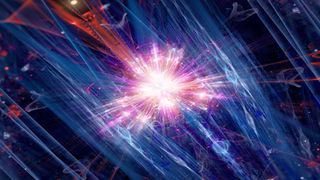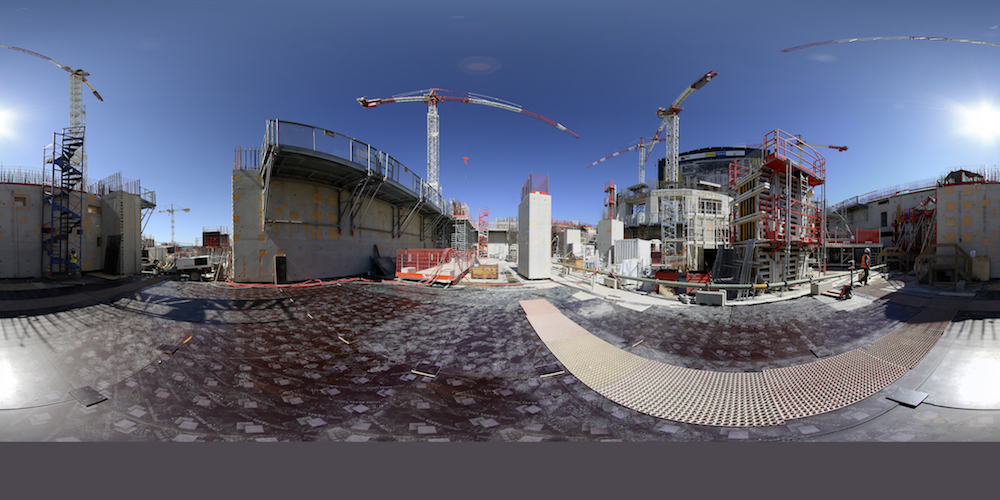Similarities Between Fission And Fusion
Fission vs. fusion: What's the difference?

Fission and fusion are both natural diminutive processes that release incredible amounts of energy, but in many ways, they are opposites. Fission involves the splitting of a unmarried, generally heavy, diminutive nucleus, whereas fusion requires the combining of two or more lite atoms.
Atoms include protons and neutrons spring together in a central nucleus. Radioactive elements, like uranium, may contain dozens of these particles in their atomic hearts.
Fission occurs when heavy elements such equally uranium spontaneously decay, which causes their nuclei to separate. Each of the resulting halves has slightly less mass than the original atomic core, and the missing mass is converted to energy.
Related: Why NASA'south Mars rover Perseverance will employ nuclear ability to stay warm
Physicists Lise Meitner and Otto Frisch discovered the principles underlying fission after receiving a private letter from nuclear chemist Otto Hahn in Dec 1938. Hahn'due south experiments showed that uranium atoms that were bombarded with neutrons would split up, and Meitner and Frisch used the new science of quantum mechanics to explain why this happened.
All three scientists soon realized the terrible implications of their discovery, which was happening under the shadow of Earth War II. A single example of fission might release a relatively small amount of ability, simply many fission reactions happening at the aforementioned time had the potential to be quite destructive if used to develop something like an atomic bomb.
Nuclear fission for energy and weapons
When a uranium atom naturally goes through fission, it releases a neutron that will careen around. If this neutron hits other nearby uranium atoms, they volition as well dissever, creating a cascading chain reaction. In 1951, engineers built the start power establish harnessing the process of nuclear fission to produce free energy, according to the U.Due south. Department of Energy.
In a nuclear power found, this process is carefully controlled. Fission releases heat, which boils water and generates steam that spins a turbine.
Simply in an atomic flop, the cascading chain reaction spirals out of control, with fission happening at an e'er-increasing charge per unit. This releases a tremendous amount of ability in a brusk span, generating the devastating blast of the bomb.
Related: 6 years after Fukushima: Has Japan lost faith in nuclear power?
Why fusion doesn't produce energy, yet

(opens in new tab)
Fusion, by contrast, has yet to be fully adult as a human power source. In nuclear fusion, two nuclei of a light element, such equally hydrogen, must overcome their natural electromagnetic repulsion and merge into a single, heavier nucleus.
The resulting entity is slightly less massive than the original two nuclei, and only like with fission, this missing mass is converted into energy. But generating enough power to blast atoms together until they stick is not piece of cake and generally requires the farthermost environment of a star's abdomen to happen.
Engineers take long dreamed of making sustained fusion reactions hither on Earth. Fusion ability would produce less nuclear waste than fission and uses relatively mutual lite elements, such as hydrogen — rather than rarer uranium — every bit a fuel supply, according to the International Atomic Free energy Agency.
Related: Nuclear fusion reactor could exist here as soon equally 2025
But creating and sustaining fusion is difficult. An international experiment to test the feasibility of using sustained nuclear fusion to produce energy has built a magnet that's equally tall as a 4-story building and 280,000 times more powerful than Earth's magnetic field, every bit part of the International Thermonuclear Experimental Reactor (ITER).
Only ITER, a scientific partnership among 35 countries, has suffered numerous delays during its construction and isn't expected to generate more than power than it consumes until at least the 2030s.
Additional resources
- Check out this helpful table that lists the difference between fission and fusion, from Chemistry LibreTexts.
- Sentinel this video from the U.S. Department of Energy summarizing how fission and fusion work.
- Learn more than about the ITER experiment on the projection's website.
Similarities Between Fission And Fusion,
Source: https://www.livescience.com/fission-vs-fusion.html
Posted by: starnerserroustere.blogspot.com


0 Response to "Similarities Between Fission And Fusion"
Post a Comment